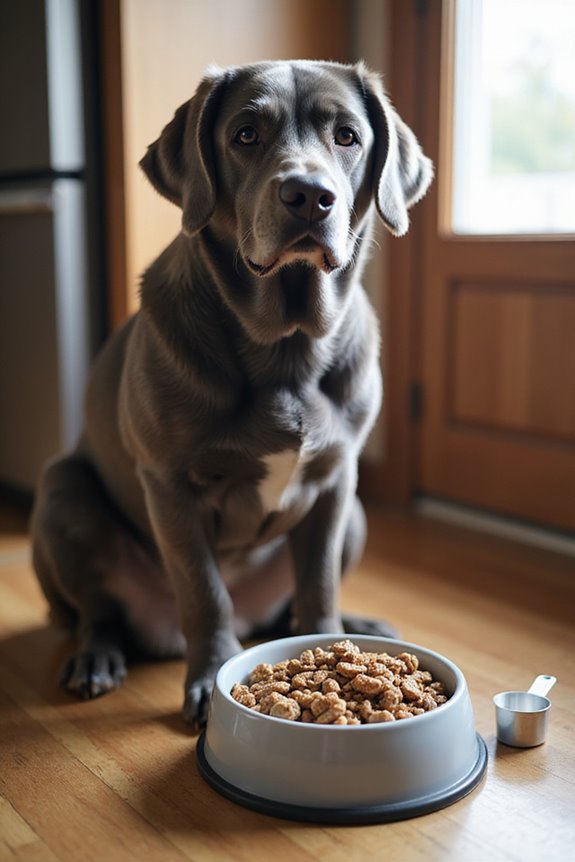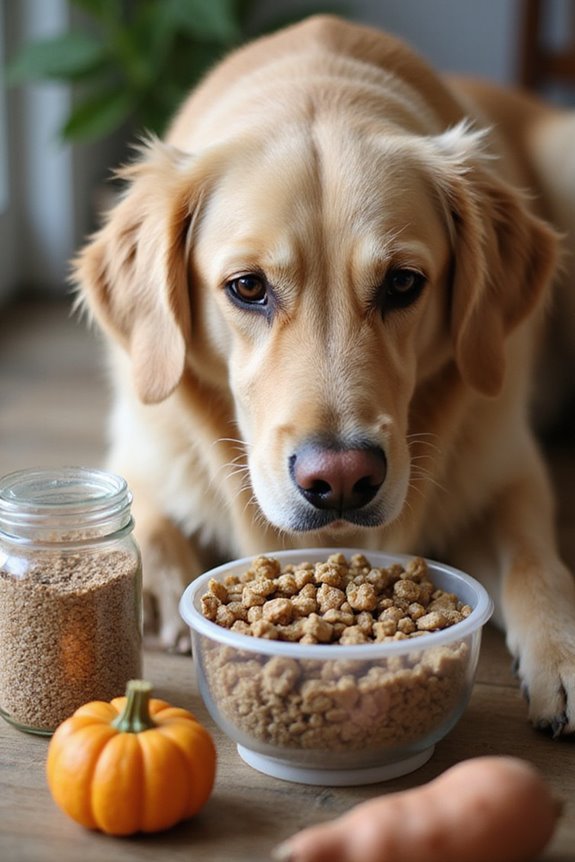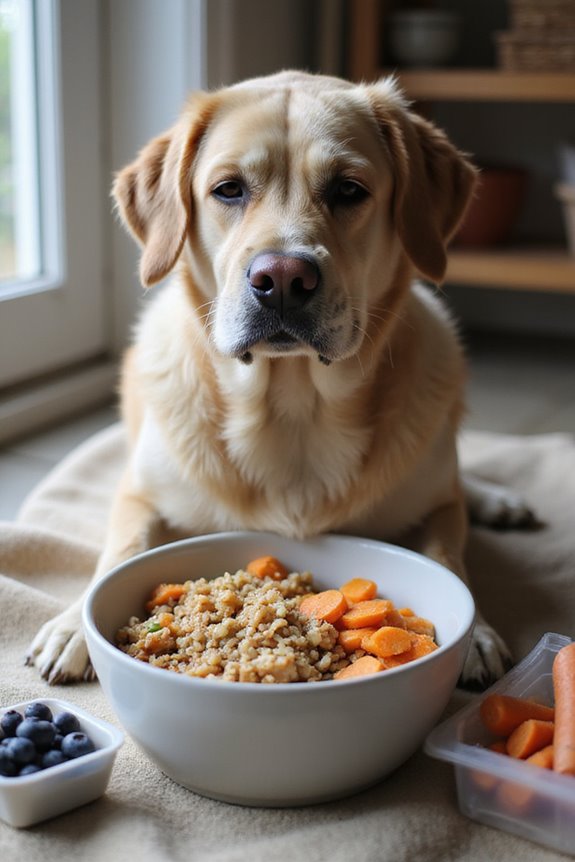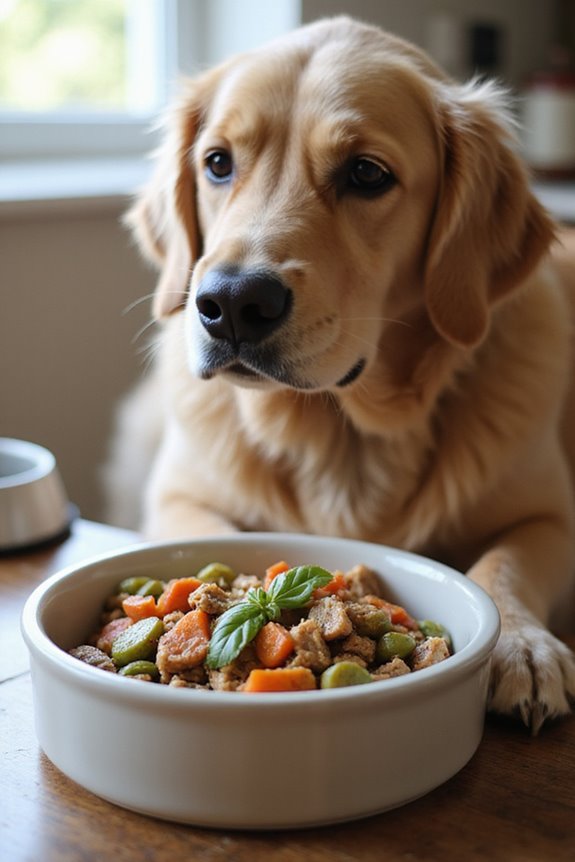For older dogs, a balanced diet should emphasize increased protein intake, making up 28-32% of their calories, to support muscle maintenance. Their caloric needs decrease, so it is vital to monitor weight and adjust portions accordingly. Include healthy fats, like omega-3s for joint health, and fiber for digestion. Choose easily digestible carbohydrates and fresh vegetables for added nutrients. Tailoring diets to individual health needs is important; consulting with a veterinarian guarantees ideal nutrition for your senior dog, leading to better health outcomes.
Key Takeaways
- Older dogs require a diet with 28-32% of calories from high-quality animal-based protein to support muscle maintenance.
- Monitor caloric intake using the Resting Energy Requirement (RER) formula to prevent weight issues.
- Incorporate healthy fats (7-15% dry matter) and omega fatty acids for joint health and skin quality.
- Include complex carbohydrates like sweet potatoes and oats for energy without excess calories, aiding in weight management.
- Tailor the diet to individual health conditions, adjusting protein, fat, and fiber levels as needed with veterinary guidance.
Understanding Protein Requirements in Senior Dogs
As dogs age, their nutritional requirements evolve, particularly when it comes to protein intake. Senior dogs have increased protein needs—about 50% more than younger dogs. It’s crucial to provide them with diets where at least 28-32% of calories come from protein. This rise is important for muscle maintenance, combating age-related muscle loss, and supporting immunity. Adequate protein intake helps maintain mobility and energy, greatly improving their quality of life. High-quality protein sources, especially animal-based proteins, offer better amino acid profiles to promote muscle maintenance. Remember, individual health status may demand a tailored approach. Consulting a veterinarian for personalized dietary recommendations can guarantee your dog’s well-being as they navigate their golden years. Additionally, incorporating High-quality protein sources into their diet is essential for optimal health and vitality.
Caloric Needs and Weight Management

When it comes to meeting the caloric needs of senior dogs, it’s essential to understand that their energy requirements differ considerably from those of younger dogs. Most seniors will need fewer calories due to reduced activity and metabolic changes. To guarantee your dog maintains a healthy weight, consider the following guidelines:
- Caloric Calculation: Use the Resting Energy Requirement (RER) formula, (70 imes (ext{body weight in kg})^{0.75}), and adjust with a multiplier of 1.2–1.4 based on activity.
- Weight Monitoring: Regularly check your dog’s weight to prevent unintentional weight loss or obesity. Safe weight loss is typically 1–5% per month.
- Caloric Restriction: Modify portions appropriately to adapt to their decreasing caloric needs, ensuring your pup stays healthy and happy.
The Role of Fat and Fiber in Senior Dog Diets

Understanding the dietary requirements for senior dogs extends beyond just caloric intake; fat and fiber play a significant role in supporting their overall health.
Role of Fat
- Ideal fat levels for seniors should range from 7% to 15% of dry matter, aiding energy without leading to obesity.
- Fatty acids, particularly omega-3 and omega-6, benefit joint health and skin quality.
Importance of Fiber
- A diet high in fiber promotes gastrointestinal health and aids in weight management.
- Incorporating both soluble and insoluble fiber types helps maintain gut microbiota and regulates blood glucose levels.
Balancing these nutrients is critical, enhancing nutrient absorption, managing inflammation, and supporting overall well-being in aging dogs. Ensuring adequate hydration is also essential, especially with higher fiber diets.
Choosing Carbohydrate Sources for Aging Dogs

Choosing carbohydrate sources for aging dogs requires careful consideration to guarantee their dietary needs are met while promoting ideal health. Here are key points to focus on:
- Opt for Grain Alternatives: Consider complex carbohydrates like sweet potatoes, brown rice, and oats, which offer steady energy without causing blood sugar spikes.
- Carbohydrate Balance: Aim for a carbohydrate proportion that aligns with reduced caloric needs, helping to manage weight and maintain muscle mass.
- Digestibility Matters: Look for easily digestible options, which will lessen gastrointestinal strain and improve nutrient absorption.
- Fresh Vegetables and Fruits: Incorporate low-calorie options like broccoli, carrots, and berries for added vitamins and antioxidants.
Importance of Phosphorus and Kidney Health

Phosphorus plays an essential role in maintaining kidney health in older dogs, especially considering the unique metabolic changes they undergo with age. It’s important to achieve an appropriate phosphorus balance, as high levels can stress aging kidneys, accelerating chronic kidney disease (CKD). A dietary phosphorus level tailored to your dog’s needs—generally between 0.3% and 1% dry matter—can help maintain kidney function without exacerbating health issues.
Monitoring phosphorus intake is vital. Excess phosphorus can lead to hyperphosphatemia, worsening renal damage. To support kidney health effectively, consider:
- Adjusting phosphorus levels based on age and activity.
- Including kidney-protective diets with controlled phosphorus content.
- Regular veterinary check-ups to monitor kidney function, ensuring timely interventions.
Individualized Nutrition for Older Dogs
Tailoring a dog’s diet to meet its individual needs is essential, especially as they enter their senior years. With senior diet customization, we can consider each dog’s unique health conditions, such as arthritis or nutrient absorption challenges, which can greatly influence dietary requirements. Consulting with a veterinarian or a nutritionist allows us to assess our dog’s body condition and any underlying issues, ensuring we address specific needs rather than relying on generic age-based diets.
Key considerations include:
- Protein Needs: Increased dietary protein may be necessary to preserve lean body mass.
- Fat Requirements: These may vary based on activity level and health status.
- Fiber Intake: Adjustments should be made for digestive health and tolerance.
- Supplements: Antioxidants and joint support should align with individual health factors.
Practical Tips for Feeding Senior Dogs
As senior dogs age, implementing practical feeding strategies becomes increasingly important to meet their nutritional needs.
To guarantee your dog thrives, consider these tips:
- Meal Frequency: Feed smaller, more frequent meals throughout the day to aid digestion and sustain metabolism.
- Feeding Environment: Create a calm, quiet space for meals, as this reduces stress and encourages healthy eating habits.
- Serve wet food at room temperature to enhance its taste and stimulate appetite.
- When storing dry food, keep it in a sealed container to maintain freshness.
- Monitor your dog’s weight regularly, adjusting caloric intake by 20-30% as needed.
- Limit treats to no more than 10% of their daily calories to prevent weight gain, focusing instead on well-balanced senior-specific dog foods. Additionally, ensure their diet includes joint health support as this can significantly enhance mobility and overall quality of life.
The Role of Veterinary Guidance in Dietary Choices
While making dietary choices for senior dogs, veterinary guidance plays an essential role in ensuring these decisions are both informed and tailored to each individual animal’s needs. A thorough nutritional assessment helps identify health conditions such as arthritis or obesity, guiding us to appropriate dietary interventions. Here are key insights:
- Custom Diets: Vets design specific diets based on a dog’s health profile, rather than using a one-size-fits-all approach.
- Protein Needs: Evaluating muscle mass allows vets to recommend higher protein diets when necessary, preventing muscle loss.
- Ongoing Monitoring: Regular vet visits are important for adjusting diets as health changes occur, maintaining ideal quality of life.
Your dog’s nutrition is a partnership; your vet’s expertise proves invaluable in making informed decisions.
Frequently Asked Questions
Can Older Dogs Eat Human Food Safely?
Absolutely, older dogs can enjoy human food, but safety’s key! Following proper feeding guidelines helps keep them safe while savoring scrumptious snacks. I always consult my vet before sharing any tasty treats with my seniors.
How Often Should I Feed My Senior Dog?
I’ve found that meal frequency for my senior dog works best with two meals a day. Portion control’s important too, so I divide his food into smaller servings to keep him happy and healthy.
Are There Specific Treats Suitable for Older Dogs?
When I think of my senior dog’s treats, I want balance—natural ingredients that are good for him and low-calorie options to keep him spry. It’s the little things that make a big difference, isn’t it?
What Signs Indicate My Dog Needs a Diet Change?
I’ve noticed my dog’s lethargy and changes in appetite, prompting dietary changes. Managing their weight is essential; it can improve their energy and overall health. Let’s monitor those signs together for our furry friends’ sake.
Can My Senior Dog Be Allergic to Certain Foods?
Yes, your senior dog can absolutely have food sensitivity. I’ve seen common allergens like beef and dairy trigger reactions. If you notice changes in their behavior or health, it’s worth discussing with your vet.




